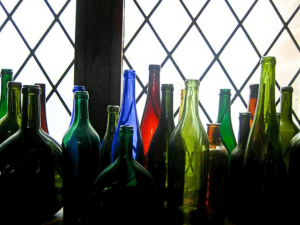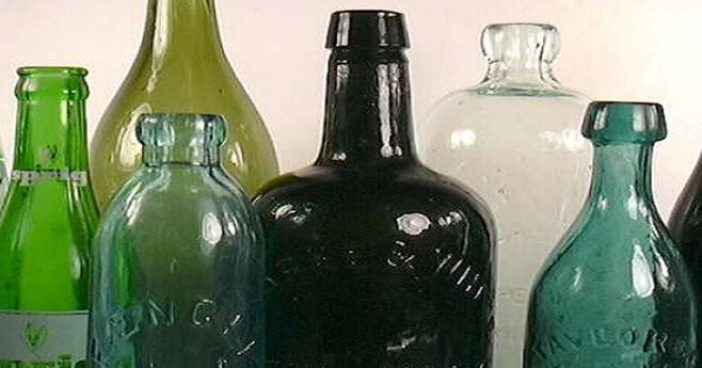
As the old saying goes, “one man’s trash is another man’s treasure,” especially if you’re an archaeologist. Various items that are typically thrown away, such as bottles, can help paint a picture of a sites’ history and are an important aspect of cultural resources management. Bottles can contain anything from ketchup, milk, beer, pickles or cold cream to champagne; what do all of these bottles – not the contents – have in common? Each of the bottle shapes is more or less instantly recognizable as a container for that specific product.
For example, the shape of the pickle jar was designed in a short, squat shape with a wide mouth for ease of removing individual pickles. Typically, bottle shapes are closely associated and identified with specific products, as “form follows function” to a large degree in bottle shapes and styles. What kinds of information can the size, shape, color, and style of bottles tell us if they are an archaeological discovery at a project site?
- Date Ranges: Because bottle types and styles change over time, they can provide a date range for when the site was occupied.
- Behaviors: The number and types of bottles found can loosely indicate types of behaviors specific to that site. For example, baby bottles, an unusually high number of medicinal bottles and an excess of alcohol bottles can often indicate the presence of a baby, a type and the duration of an illness, and a celebration or prolonged use of alcohol.
- Trade Routes: The place of origin of bottles, as well as the products they contain, can provide an understanding of what consumers were purchasing and whether they were locally produced or exported regionally, nationally, or worldwide.
- Economic Status: The types of bottles indicate the types of products being utilized at a site and that information can indicate the socio-economic status of the site’s occupants and the locale.
- Reuse practices: Because of their durability, historic preservation of evidence helps indicate that bottles were often reused for other products once the original product was finished.
Chronology
Perhaps the most important information bottles can provide is an indication of an archaeological site’s chronology. The two primary factors involved in dating bottles are bottle and glass production techniques, and the presence of embossed makers’ marks. One of the first indicators of early bottles is their method of manufacture. The year 1905 represents a watershed in bottle manufacture as a bottle-making machine was perfected at that time, ushering in full-scale production of machine-made bottles. Prior to this invention, bottles were produced by hand-blowing or by the use of semi-automatic mold machines.
Machine-made bottles are identified by the presence of a mold seam, which runs up the side of the bottle and through the lip (top) of the bottle. Hand-blown bottles have no mold seams. Using semi-automatic molds produce a seam running up the body but ending below the lip. In hand-blown and semi-automatic bottles, the lip of the bottle was applied by hand in a separate step and was characterized by a smooth, non-seamed appearance. Until 1917 only large bottles were machine-made but after this date all sizes and shapes were machine-produced. By 1924, it is estimated that 90 per cent of glass containers were produced by automatic machines. However, some limited-production bottle types, such as pharmaceuticals and cosmetics, continued to be made with applied lips into the 1930s.
One of the most consistent ways to date bottles manufactured prior to World War I is derived from the presence of purple glass. The silica-based sand used to produce glass invariably contains iron impurities that introduce an aqua tint to the otherwise-clear glass. From antiquity glass makers have tried to eliminate the aqua tint by a variety of means. From 1880 to 1914, manganese was used by American glass manufacturers to produce clear glass. However, when exposed to sunlight the manganese in the glass reacts chemically and acquires a purple hue. In 1914, the government commandeered manganese supplies for use in World War I and selenium was used instead to eliminate the aqua tint. Thus, bottles that have a lavender or purple tint are typically characteristic of bottles created prior to World War I. Lavender or sun-colored glass can also be an indicator of ground disturbance at a site. If lavender glass is found beneath the ground surface, it must have been exposed to the sun — and therefore been above ground — at some point in time.
Another indicator of bottle chronology is the maker’s mark or the presence of embossed labels. The vast majority of bottles with embossed lettering were manufactured between 1869 and 1933. Embossed lettering can occur as makers’ marks or labels and slogans on the sides of bottle. The advent of machine-made bottles also led to the use of paper labels that were more colorful, informative, and above all, cheaper to produce than embossing.
Unfortunately, paper labels do not preserve well in archaeological sites and their rise in popularity represents a significant reduction in the number of cultural and chronological bottle criteria available to the historical archaeologist.
So, to return to the title of this article, what can historic bottles tell us? They can provide a range of dates to determine the site’s period of occupation; they can add to the knowledge base of the site’s occupants and their status, habits and customs; they can point to associations with others locally and worldwide through trade; and finally, they can help us understand if a site has been altered over time or if it has remained intact.
The importance of what the bottles can tell us lies in the fact that often historic records do not tell the whole story. Formal documentation of a city block, for example, may indicate that the residents were upper-middle class Swedish people who bought their food locally. The archaeological evidence, in the form of bottles and glassware, may suggest that the community was far wealthier than the formal record showed – as evidenced by expensive perfume and champagne bottles and cut crystal stemware. In addition, although the residents purchased from local purveyors, the bottles may indicate that the majority of their purchases included commodities and liquor from their homeland.
If you would like more information of what historic materials such as bottles and ceramic wares can tell you about a particular site from a cultural resources management perspective, please feel free to talk to one of our specialists on cultural resource assessments, or talk to one of our historians.
Did you enjoy this post? The author of this article is Carrie Wills. Learn more about her here.





